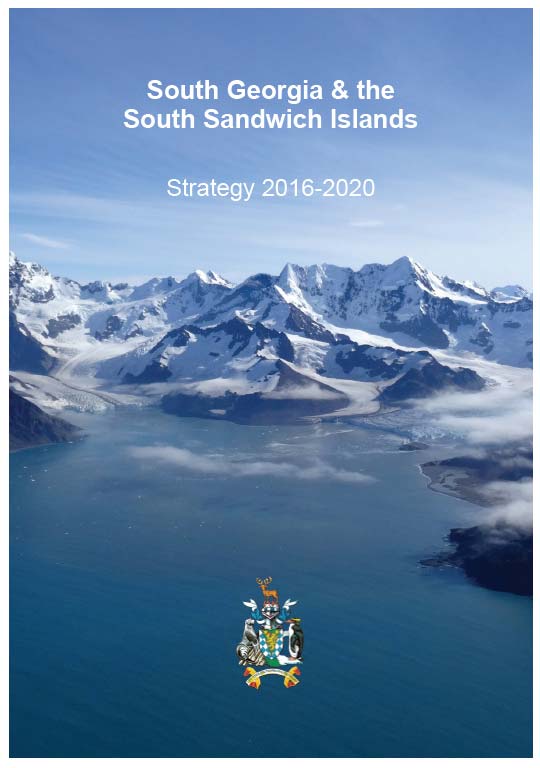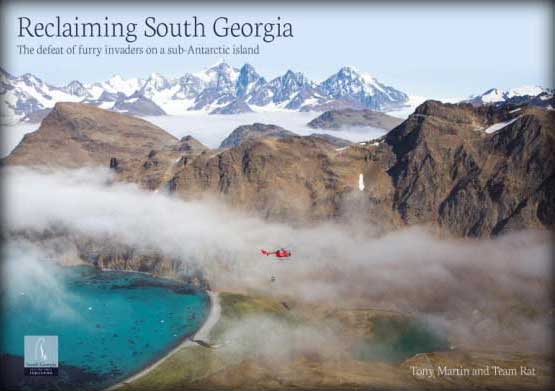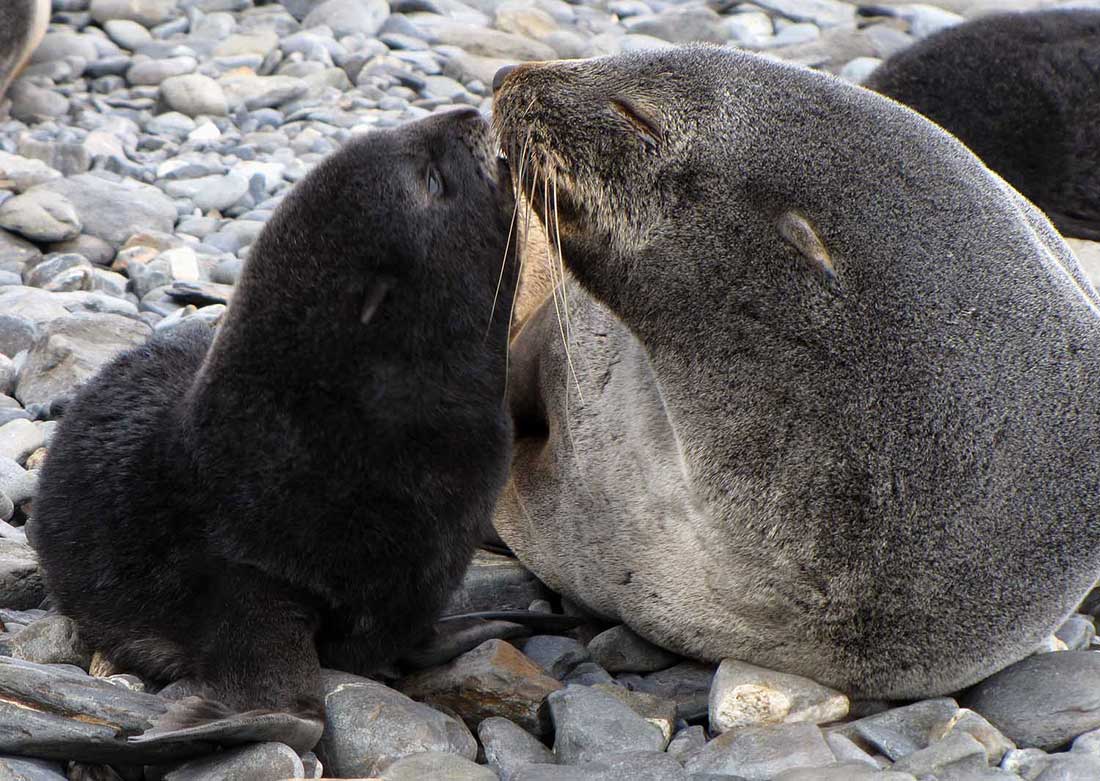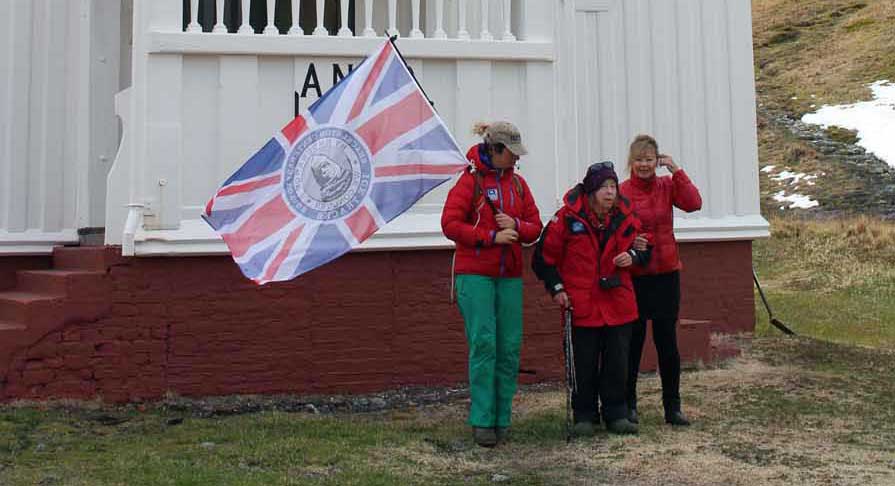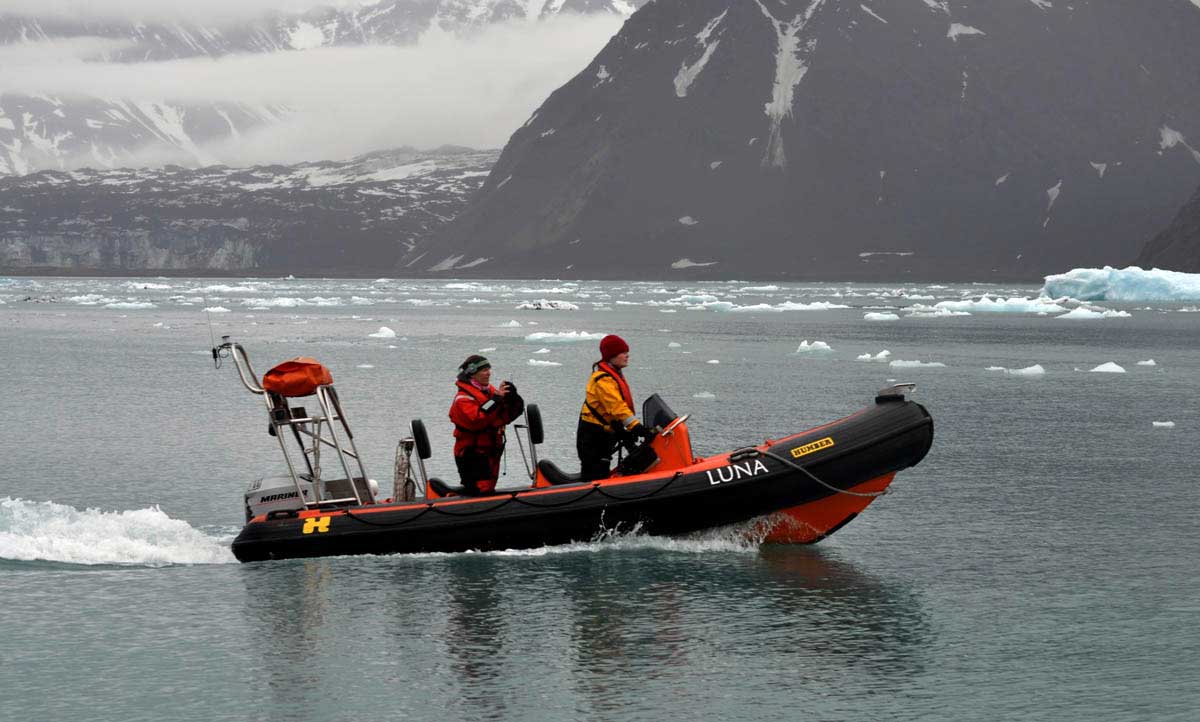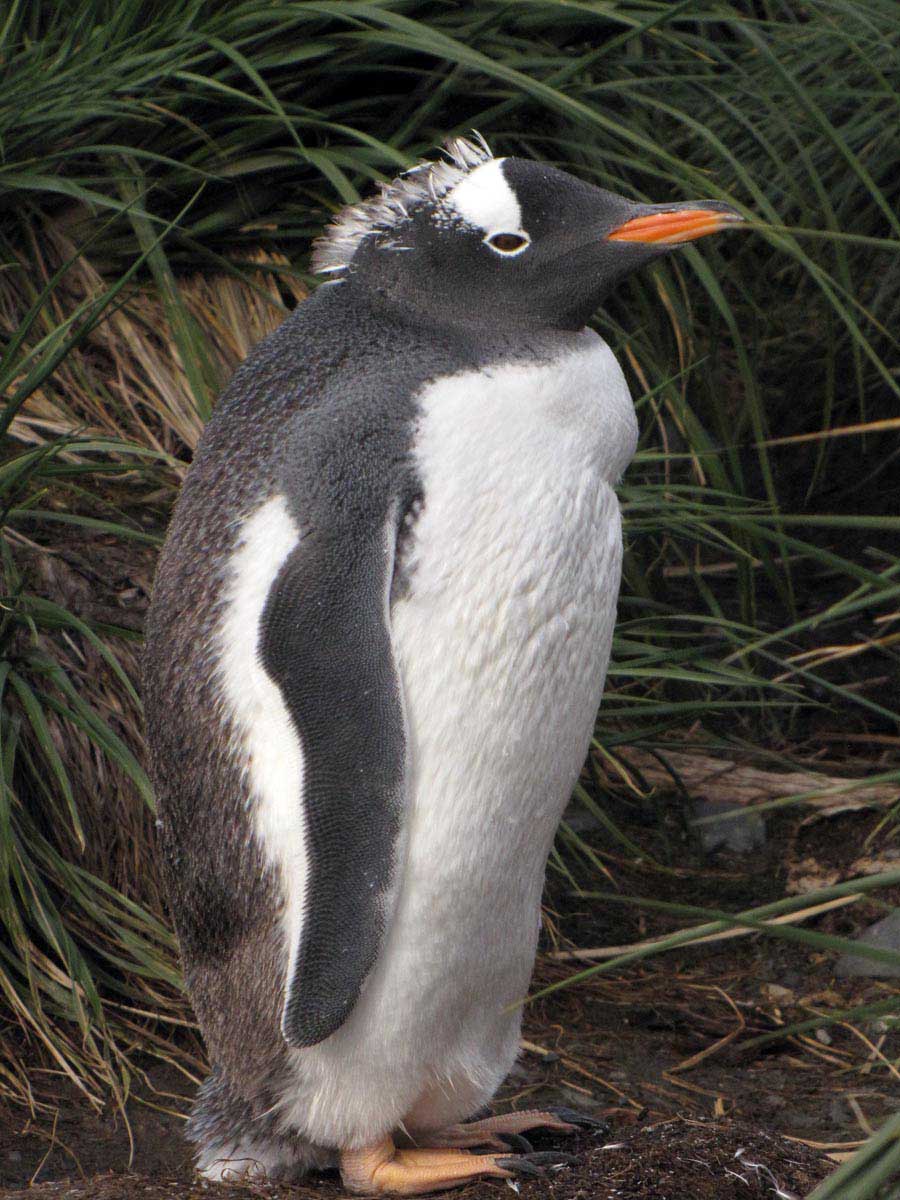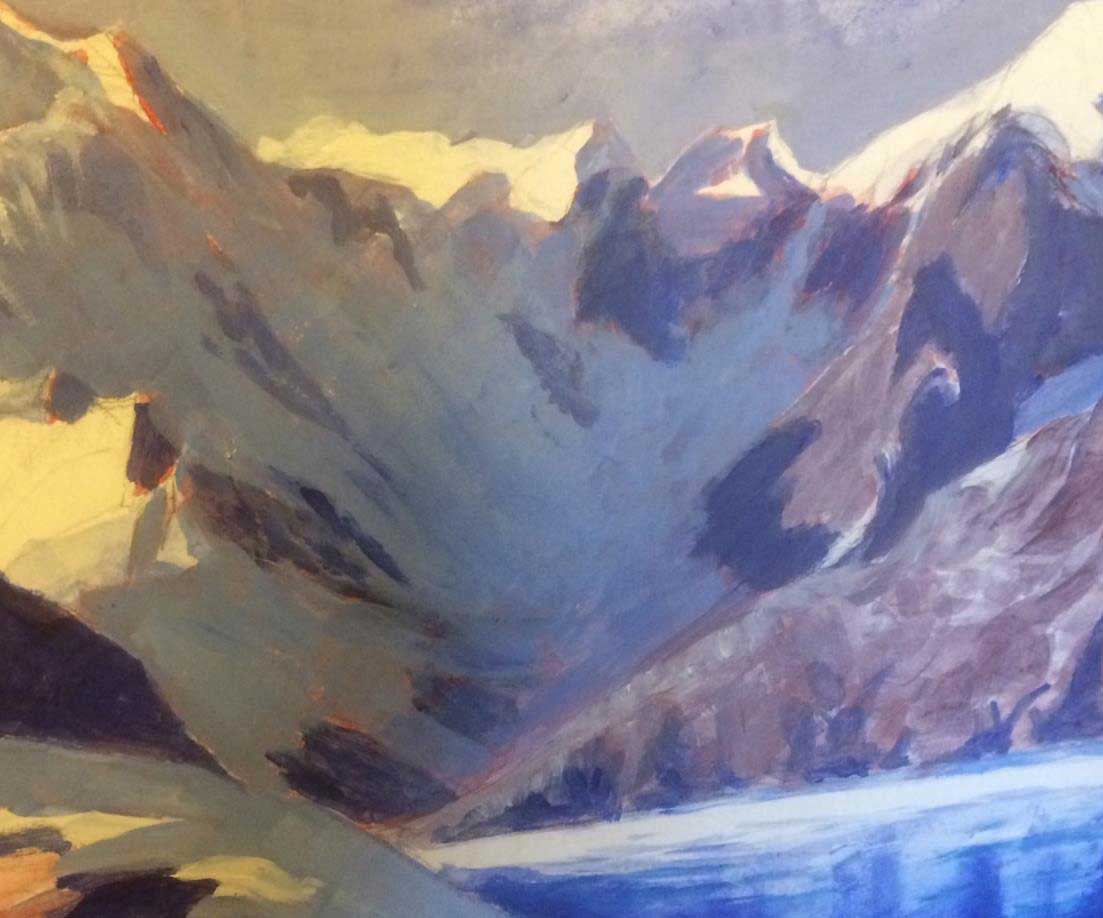This newsletter is not produced by GSGSSI; it does not necessarily reflect their views.
To subscribe to the SGIsland News Alerts list click here
A new five-year Strategy for South Georgia & the South Sandwich Islands 2016-2020 was published on 27th November. The Strategy sets out an ambitious agenda to deliver the highest standards of environmental stewardship and governance for this British Overseas Territory.
The Strategy has been developed in close consultation with organisations and individuals who share a common interest in better understanding, protecting and enjoying South Georgia & the South Sandwich Islands.
Over the next 5 years, the Strategy commits the Government of South Georgia & the South Sandwich Islands, supported by the UK Government, to:
- further enhance environmental protection, through revising the Marine Protected Area Management Plan, designating new terrestrial protected areas and strengthening bio-security;
- strengthen stakeholder engagement and outreach, and enact new legislation for the better governance of the Territory;
- further increase standards and sustainability in the fishery – already Marine Stewardship Council certified as among the best managed in the world;
- look at the way tourists and other visitors experience the Territory to better support safe, sustainable and environmentally sensitive visits; and
- adopt a new approach to better conserve South Georgia’s heritage.
Minister for the Overseas Territories and Polar Regions, James Duddridge said: “South Georgia is a true jewel in the Southern Ocean – an incredibly rich and diverse natural environment – where wildlife flourishes like nowhere else. So I am delighted that this new Strategy, owned by both the UK and the South Georgia Government, sets out such an ambitious vision to ensure that the Territory continues to live up to its deserved reputation as one of the most environmentally responsibly managed places in the world.”
Colin Roberts CVO, Commissioner for SGSSI said: “This new Strategy sets out an ambitious vision – to establish South Georgia & the South Sandwich Islands as a world leader in environmental management, with the highest standards of governance. It has been based on extensive stakeholder engagement and I invite all those who share our desire better to understand, protect and enjoy this exceptional Territory to work with us in taking the Strategy forward.”
James Jansen, CEO said “This new Strategy marks the beginning of a 5-year programme of work that will build on and further develop the sustainable management of South Georgia & the South Sandwich Islands and help to safeguard its future, not least in the face of uncertainties about environmental change. It is an undertaking that Government alone cannot deliver. I look forward to working closely with our many stakeholders to deliver this Strategy in the years ahead.”
The new Strategy can be found at: www.gov.gs/information/south-georgia-strategy/
A serious fire on board a cruise ship in November led to a large-scale rescue operation off the Falkland Islands and means that three visits to South Georgia in the new year are likely to be cancelled.
Le Boreal, which usually brings 200 passengers to South Georgia each visit, has cancelled at least two trips to South Georgia following an engine room fire on 18th November when she was just north of the Falkland Islands and on her way to South Georgia. With the engines incapacitated the vessel was initially drifting and in danger of being wrecked on the nearby coast. The Master made the decision to abandon ship. Despite very big seas and near gale force winds, all 347 passengers and crew were safely evacuated using the life rafts, ship’s tenders and with assistance from several helicopters, other aircraft and ships. These included RAF Search and Rescue, Bristows and British International helicopters, HMS Clyde, an oil-rig support vessel Pacific Leader and an MOD tug. The stricken vessel’s sister ship L’Austral was also quickly on the scene. Passengers and crew were conveyed to Stanley where the local community rallied round to provide clothes and accommodation. Le Boreal was taken under tow to Mare Harbour in East Falkland where initial repair work was undertaken, before the vessel was taken under tow again for further repairs.
A week later a fur seal bite sustained by a passenger travelling on board the cruise ship MV Akademic Sergei Vavilov required the ship to sail directly back to the Falkland Islands to provide for specialised medical treatment. The passenger was airlifted to hospital in Stanley en route, courtesy of the Royal Navy and Royal Air Force.

The NZAHT Expedition group. Left to right, Kevin Nicholas, Nigel Watson, Sinéad Hunt, James Blake, Tom MacTavish, and Sean Brooks. Photo Carol Benfield.
I’ll never forget my first proper view of South Georgia. We were approaching King Haakon Bay and the jagged peaks and snow-plastered buttresses of rock that reared out of the ocean in front of us were like the turrets and ramparts of a mystical white castle. Not only was it a view of staggering beauty, but it also signified the beginning of an expedition that I’ll cherish for the rest of my life.
I visited South Georgia in late October 2015 as one of three young people chosen by the New Zealand Antarctic Heritage Trust (NZAHT) to participate in a sponsored ski-mountaineering expedition. The expedition’s aim was two-fold: to mark the centenary of Sir Ernest Shackleton, Tom Crean, and Frank Worsley’s original crossing of the island; and to create a conduit for inspiring the next generation of explorers. In keeping with the make-up of the original party, the Trust selected one person from England (James Blake), one from Ireland (Sinead Hunt), and one from New Zealand (me, Tom MacTavish). The expedition was led by Nigel Watson, NZAHT Executive Director, and was guided by two mountain guides from One Ocean Expeditions.
It was the unique combination of ingredients – history, wildlife, and wild weather – that made the centennial re-crossing of South Georgia so special for me. In King Haakon Bay we were able to use Worsley’s little sketch map to find the same glaciers, islands, and kelp reefs that Shackleton, Worsley, and Crean had seen 100 years ago. In Fortuna Bay we ate our dinner in the vicinity of tuxedo-clad king penguins and then tried to sleep while listening to the primordial bellows of bull elephant seals. And, on our final crossing into Stromness, we were struck by winds so strong that two of us were literally blown off our feet. It was that same combination of ingredients that I enjoyed at a broader level after our crossing as we explored Grytviken and some of South Georgia’s beaches from the comparative luxury of the ship.
One of the most rewarding aspects of the experience has been sharing the expedition with others. During the expedition we blogged regularly to thousands of followers on social media (see the Trust’s Facebook page https://www.facebook.com/Antarctic.Heritage.Trust) and we carried a satellite tracking device which meant our progress across the island itself could be followed live on the internet. Now, after returning home, our emphasis has switched to presentations and broader film and written outputs. Last week I visited three New Zealand schools. It was a real buzz to see young people, not only inspired to explore, but also fascinated by South Georgia and its incredible human and natural history.
I’d like to extend my heartfelt thanks to the GSGSSI, the NZAHT, and One Ocean Expeditions for making the expedition possible, and I certainly hope that one day I’ll see again the remarkable shores of South Georgia.
Reclaiming South Georgia is the story of the SGHT Habitat Restoration Project fieldwork that took place on South Georgia in three phases (in 2011, 2013 and 2015). The text and photographs tell the story of how this world-leading project baited every square inch of rodent-infested land on the island. Although the main baiting phase was completed earlier this year, the project is far from finished. Much work remains to be done in the coming years to check if rodents have indeed gone and this book has been created to raise funds for this crucial monitoring phase of the project.
Every photo in the book was taken by a member of ‘Team Rat’, as the field team is affectionately known. The story is a personal account by Project Director Professor Tony Martin of the considerable challenges and triumphs involved in routing the furry invaders.
‘Reclaiming South Georgia’ is an inspiring story of how a globally important wildlife haven, badly damaged by human intervention, was set on the road to recovery by humans of a later generation. … In a world of seemingly endless bad news about the environment, this is a rare story of hope and success in the face of huge challenges.
“Reclaiming South Georgia, The defeat of furry invaders on a sub-Antarctic island” by Tony Martin and Team Rat, is available from the SGHT online shop http://www.sghtonline.gs/Reclaiming-South-Georgia.
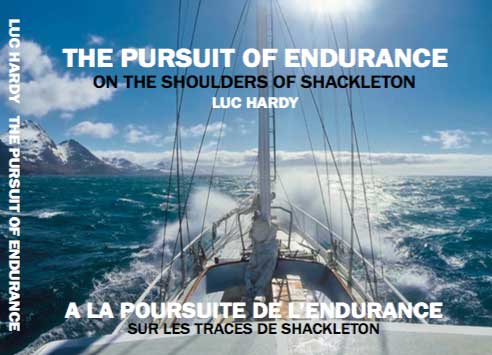
A diverse group of nine adventurers set out to explore the story behind the rescue of the crew from Shackleton’s Endurance expedition. The modern expeditioners came from very different backgrounds – an expedition leader, a veteran explorer, a former officer, a skipper, a polar guide, a scientist, two young soldiers and an athlete snowboarder – but one thing brought them together, a passion for adventure and testing the limits. Their goal was to follow in the footsteps of one of the greatest legends of the golden age of polar exploration: Ernest Shackleton.
The new book, ‘The Pursuit of Endurance – On the Shoulders of Shackleton’, explores the original heroic story and tells of the modern adventurers’ experiences as they follow to Elephant Island, South Georgia and go to the South Sandwich Islands using a boat, skis and pulks.
The expedition set out to “remind us of the fragility of this highly endangered ecosystem, and to improve our understanding of these remote expanses”. Published during the centenary of the Endurance Expedition, author Luc Hardy is hoping his book will, “inspire a new conversation about the global challenge of climate change through adventure, science, wildlife observation and the poetry of sporting achievement”. He describes their modern expedition as “A true scientific eco-adventure at the end of the Earth”.
The book, published by Sagax Publishing, has 232 pages and over 400 colour photographs, graphs and maps and is written in both French and English. It has a foreword written by former President Mikhail Gorbachev and a preface by Jean-Michel Cousteau.
ISBN-13: 978-0-9746080-4-4
All profits from the sale of the book benefit Green Cross International. For more details and a chance to see more of the book and/or purchase a copy go to http://www.paxarctica.org/the-pursuit-of-endurance
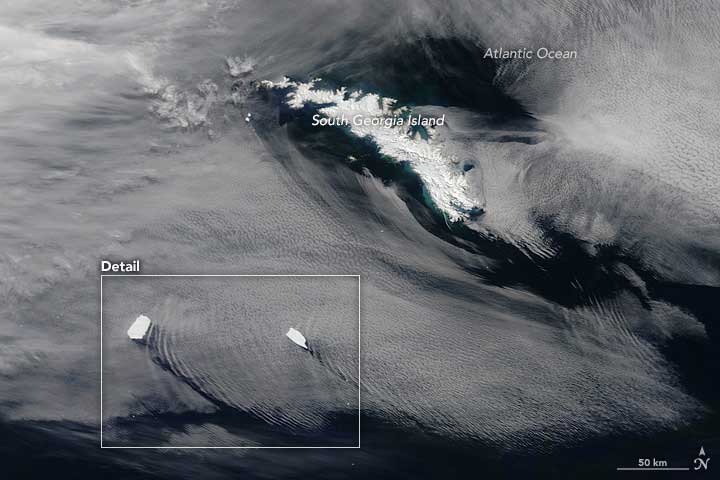
The big tabular berg create a distinctive cloud pattern. Photo Jeff Schmaltz, MODIS Land Rapid Response Team, NASA GSFC.
A satellite photograph of two big icebergs off the south-west coast of South Georgia shows the effect of the giant ice lumps on the lower atmosphere. These tabular icebergs are sections of Antarctic ice shelf that broke off the continent further south and drifted up towards South Georgia.
The true-colour photograph above was taken by the Moderate Resolution Imaging Spectroradiometer (MODIS) on NASA’s Terra satellite on November 27th. It shows how the vast icebergs (and the smaller ones too if you look carefully) interrupt the flow of the air layers, creating wave-like cloud patterns downwind.
“Cloud wakes are most evident in the lee of the two larger icebergs,” said Kelly Brunt, a glaciologist at NASA’s Goddard Space Flight Centre. “Wave clouds occur when a higher-level air mass is forced to move up and over a large obstacle. For example, wave clouds are commonly observed when air passes over islands. Unlike the low-level fog that leads to a cloud wake, the air mass that forms wave clouds does not have to be at the same level as the icebergs. It simply must encounter a disturbance large enough to force the air up, instead of around.”
The 2015-16 summer season on Bird Island is well and truly underway. As someone who initially came down in November 2012 (as Field Assistant working on the penguins and petrels) I can’t believe how quickly the time has passed; almost all of it spent down here. I fell so quickly back into business as usual at Bird Island that the last six months in the UK feel like a dream.
The long journey down, on board the BAS ship RRS James Clark Ross was smooth and enjoyable with plenty of excitement going through the ice to help dig out Signy Station, then close views of humpback whales while the marine scientists were working at sea deploying and retrieving instruments.
After a day waiting for the sea to calm we got the extremely early morning call that we were going ashore to Bird Island. It was still too rough to start ferrying cargo ashore so I had a half day showing new people around the station and the highlights of the nearby seal study beach and wandering albatross study area. An afternoon start to the cargo movements meant a late evening, but a huge amount was done with the help of a willing team from the ship who unloaded tonnes of science, technical, computing and domestic equipment, as well as mountains of food.
A few days of rough weather meant the ship disappeared for a few days. Returning once the weather abated, we had a second day of cargo movements and refuelling, then the ship headed off leaving just seven of us here for the summer. With such a small team we will be relying on each other more than usual, and so far everyone has had the chance to get out and help with a whole range of jobs – daily seal work is at its busiest as the beaches are filling up with pups being born and we have been weighing the near full-grown wandering albatross chicks and completing a census of all the giant petrels nesting on the island. The latter requires walking transects back and forth up and down the slopes which is quickly rebuilding those tussac-climbing muscles.
Want to keep in touch with news from Bird Island? There are several blogs you can follow listed below:
remembertherazorbill.blogspot.co.uk
raisedbypuffins.blogspot.co.uk
Relatives of the Endurance and Nimrod crews visited South Georgia in November aboard the cruise ship Akademik Ioffe. The cruise coincided with the centenary of Shackleton’s Endurance expedition, so it was fitting that a service was held in the church to mark the remarkable men who took part in this expedition. The service, organised by Angie Butler of Ice Tracks and led by Government Officer Simon Browning, was attended by the cruise ship passengers and by some of the locals.
The two relatives of the original Imperial Trans-Antarctic Expedition members were traveling with the Ice Tracks party. Anne Phillips is the grand-daughter of Aeneas Mackintosh who was leader of the Ross Sea party. He lost his life laying depots for Shackleton’s planned attempt to cross the Antarctic Continent. In an address Anne said that the remaining family of Aeneas Mackintosh are all “very proud to be the descendants of such a brave and self-sacrificing ancestor.”
Also at the service was Robin April Stork, a relative of Frank Wild whose ashes were interred in Grytviken cemetery a few years ago alongside Shackleton’s grave. She also made a moving address. After the well-attended service the congregation walked to the cemetery to lay a wreath on Frank Wild’s grave. Attached to the wreath were several more of the original “in sympathy” cards from Wild’s original funeral in South Africa, including one from fellow expeditioner Huberht Hudson and from some of his mining colleagues. These were given to Angie Butler by the Wild family and have now joined others in the collection of the South Georgia Museum.
New Boats Called Molly and Sooty: Two new RIB launches have arrived at KEP to replace the two older RIB launches Luna and Alert. Called Molly and Sooty, they are powered by petrol outboard motors and are used to support government and science activities mainly in the Cumberland Bay area.
Sally in the Guardian: Sally Poncet featured as the subject of a long article in the Guardian Newspaper on November 13th. Sally, who has had a long association with South Georgia as a yachtswoman and field researcher, was awarded a Polar Medal earlier this year. The article describes her adventurous career and highlights that she is one of only a handful of women to be awarded the Polar Medal. You can read the article here.
Award Winning South Georgia Sea Kayak Expedition: A group of Australian kayakers has won the Australian Geographic’s 2015 Adventurers of the Year Award for their circumnavigation of South Georgia. The four paddlers completing the circumnavigation in 13 days, six days faster than anyone before them. They then went on to do the Shackleton Traverse.
www.news.com.au/travel/world-travel/antarctica/south-georgia-island
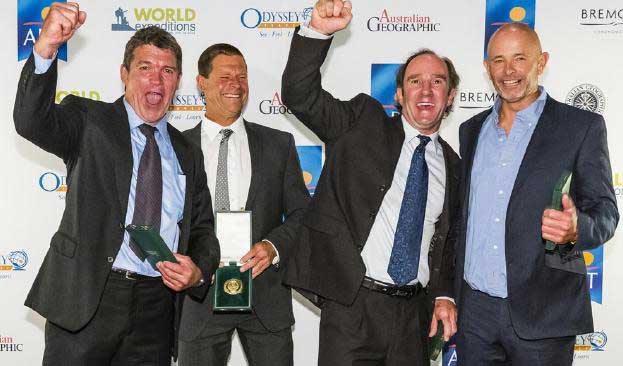
Winners of the ‘Adventurer of the Year’ award at the 2015 Australian Geographic Society Awards. Picture: Australian Geographic.
On the Bucket List: South Georgia has been listed as one of the “20 Must-see places for 2016” by National Geographic magazine. The full list of the must-see places are listed in the December 2015 ‘Best of the World’ issue of National Geographic Traveller.
Bad Season for Gentoos: Many gentoo colonies on the north coast of South Georgia have been abandoned early in the breeding season. The birds came in to nest and laid but then appear to have left. The eggs remain on the abandoned nest unguarded. The usual hilltop colonies near Husvik were all empty, and reports from other colonies show a similar pattern. However other colonies seem to have managed better. For those birds that remain incubating, the chicks are now beginning to hatch.
The colony collapses may be associated with a lack of food close to shore. Gentoos go to sea to feed each day, so cannot get far out to sea before returning to roost or returning to the nest. The lack of food may be associated with the current El Niño event.
Fur seals main food source is also krill. The seals coming up to breed in early season looked to be in very good condition with plenty of body fat. Bird Island is experiencing lower numbers of females than might be normal for this time of year, but at Grytviken and Maiviken numbers look more normal, the fur seal population in this area has been increasing year on year. At the end of November the fur seal females were pupping.

Sarah Lurcock presents Stephanie Winnard (left) with a bottle of champagne for finding the first breeding pipits in the southern area.
Bubbles for Birds’ Nests: The first pipit nests have been recorded in the recently baited Phase Three area of the SGHT Habitat Restoration (rodent eradication) Project. This is really quick re-establishment of breeding birds on the main island as the area was only baited to remove rats in March this year.
Pipits, which could not successfully breed where rats were present, have been one of the first birds to return to the newly rat-free areas. For each of the three phases, baited in 2011, 2013 and 2015, a bottle of champagne was on offer for the first recorded pipit nesting.
The first nests (probably two) in the Phase Three area were discovered in the Rookery Bay area by BAS scientist Stephanie Winnard. SGHT Director SG Sarah Lurcock was delighted to present Stephanie with the celebratory bottle of fizz.
One bottle of champagne remains to be claimed – the bottle is offered by the South Georgia Association (SGA) for the first nest recorded on the Thatcher Peninsula, which lies within the Phase One area. The chance to win the last bottle won’t last long as pipits are regularly seen on the Thatcher Peninsula, though no nest has yet been confirmed.
Editor Retiring: Editor Sarah Lurcock, who has been collating and writing this monthly newsletter for ten years, is retiring from the role. GSGSSI would like to thank Sarah for her outstanding contribution over the past decade in bringing South Georgia news to our distinguished readership, and in creating an extraordinary archive of news material through such an eventful period in South Georgia’s history.
A hundred years ago Shackleton’s Imperial Trans-Antarctic Expedition was underway and so most of the events highlighted in this section relate to the Shackleton Centenary events. Shackleton had strong links with South Georgia and is buried at Grytviken.
The Enduring Eye: The Antarctic Legacy of Sir Ernest Shackleton and Frank Hurley
An exhibition at the Royal Geographical Society, Kensington Gore, London, to coincide with the centenary of the Endurance expedition, and inspired by glass plate negatives of the expedition selected and saved from the ice by expedition photographer Frank Hurley and Sir Ernest Shackleton.
The exhibition is supported by the GSGSSI and an off-shoot of the exhibition will be hosted at South Georgia in a new display space created at the back the old Slop Chest at Grytviken.
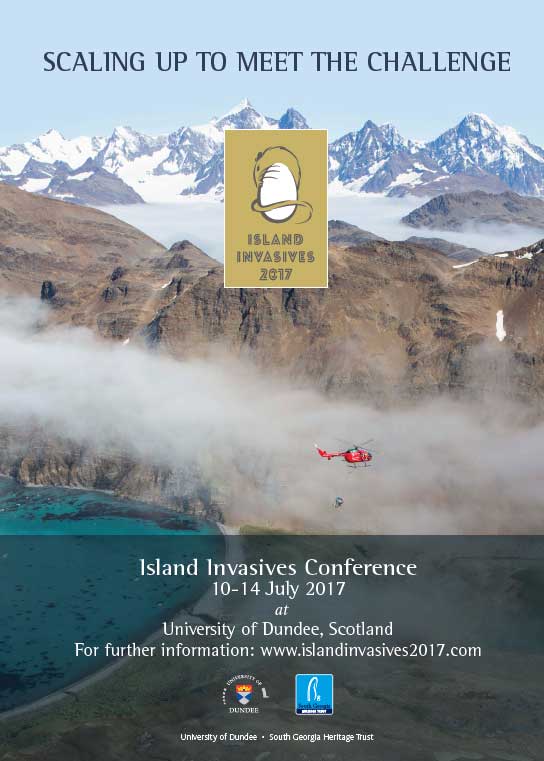 Island Invasives Conference: This, the third in the series of Island Invasives conferences will be hosted by the SGHT and the University of Dundee in Dundee, Scotland, in the week July 10-14, 2017.
Island Invasives Conference: This, the third in the series of Island Invasives conferences will be hosted by the SGHT and the University of Dundee in Dundee, Scotland, in the week July 10-14, 2017.
The conference follows two very successful and productive predecessors held in Auckland, New Zealand; the most recent in January 2010. The sub-title of the 2017 conference is ‘Scaling up to meet the challenge’ – a reflection of the rapid growth in interest in the field, as well as the escalating size of islands now being freed of damaging invasive species. The Dundee meeting will be the first in the series to be held in Europe, and the organisers are hoping the location of the conference will enable greater participation, not only from the very active groups in the Antipodes, but also from the growing interest groups in Europe, N. America and elsewhere.
As with the preceding two conferences, the IUCN (International Union for the Conservation of Nature) will publish the proceedings of the conference.
Further information about the programme will be announced shortly.
There are reduced rates for early booking. Book via conference website www.islandinvasives2017.com
By Endurance we Conquer: Shackleton and His Men: The Polar Museum at Scott Polar Research Institute in Cambridge is hosting a centenary exhibition to commemorate all the men who sailed with Shackleton aboard the Endurance. The men in the Ross Sea Party that laid the supply depots for the planned crossing of the Antarctic continent, and three of whom lost their lives, will also be commemorated. The exhibition runs until June 18th 2016.
Antarctic Explorer and Lifetime Adventurer: Tom Price
The life of Tom Price is celebrated in an exhibition at the Keswick Museum and Art Gallery, England. Tom Price (1919-2013) took part in the South Georgia Island Surveys in 1955. (This series of surveys, under the leadership of Duncan Carse, charted the interior of the island to produce maps that were still in use only a few years ago.) The exhibition includes two items on loan from the South Georgia Museum – a sleeping bag and primus belonging to Tom Price. The exhibition also showcases Tom Price’s accomplished artwork, including paintings of South Georgia. The ‘Antarctic Explorer and Lifetime Adventurer: Tom Price’ exhibition runs until February 6th 2016.
At a time when scientists are realising that the vast planktonic blooms in the seas in the area of South Georgia are an exciting and important area for future science research, this colourful image of the plankton blooms between the Falkland Islands and South Georgia was posted by NASA. The image, which was caught by the Visible Infrared Imaging Radiometer Suite (VIIRS) instrument aboard NASA-NOAA’s Suomi NPP satellite, was taken on November 23rd. You can see the Falkland Islands to the west of the picture and South Georgia lies to the east.
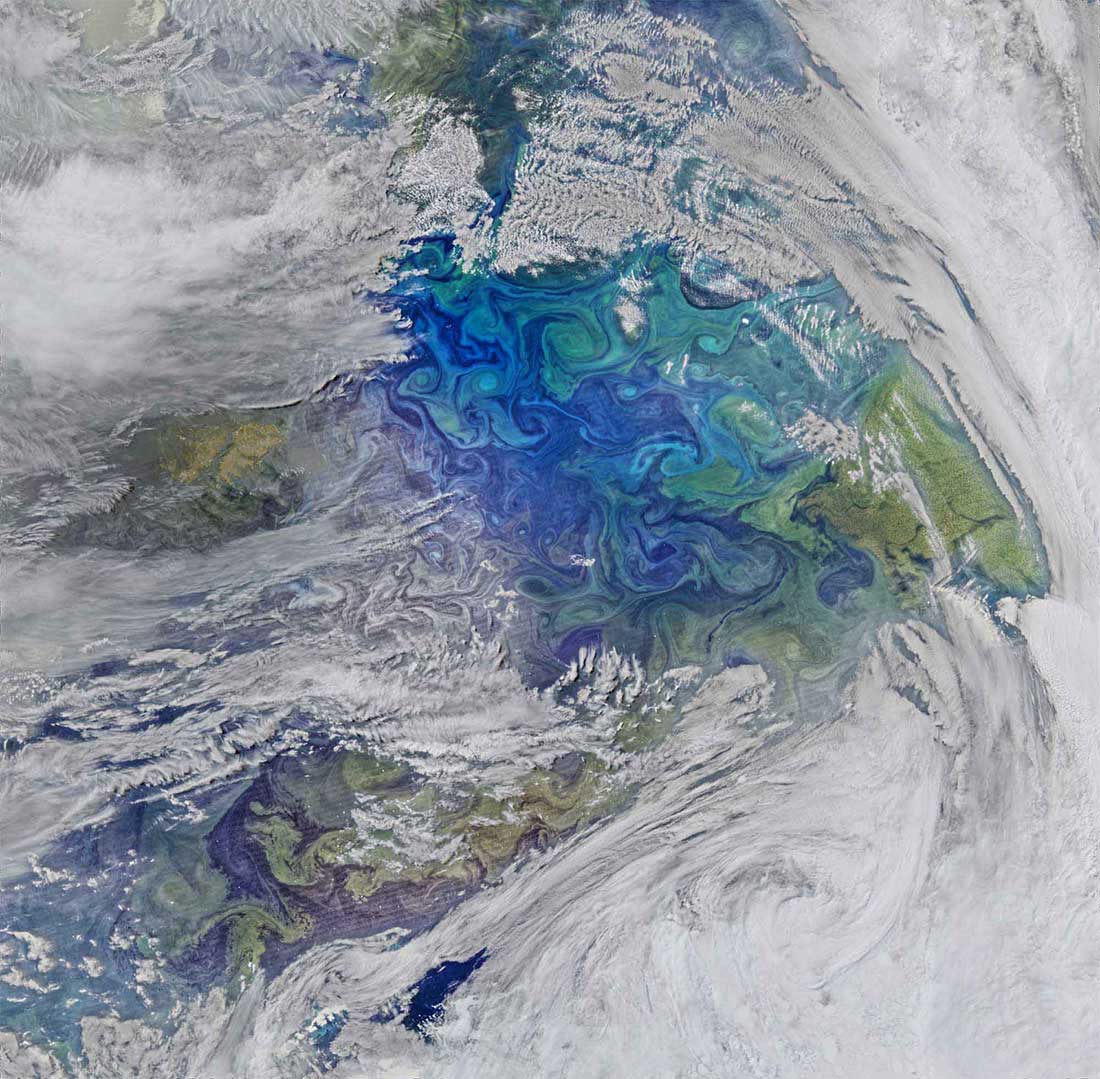
Swirls of planktonic blooms show in this infrared image taken by NASA of the sea between the Falkland Islands and South Georgia.
And finally, Season’s Greetings to all our newsletter readers. We wish you a merry Christmas and a happy new year.


